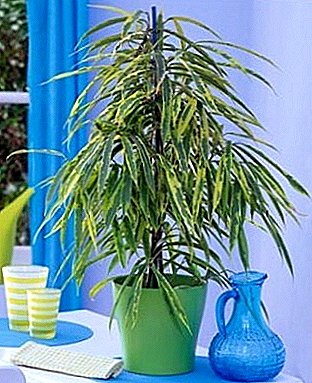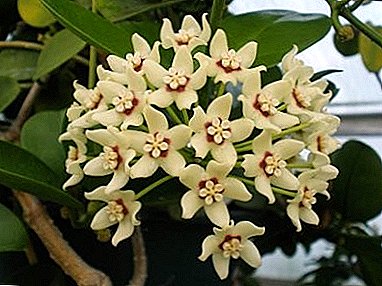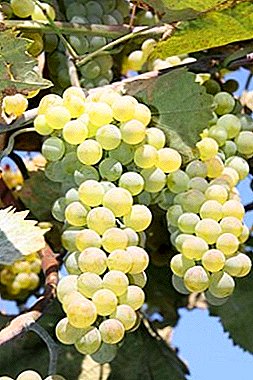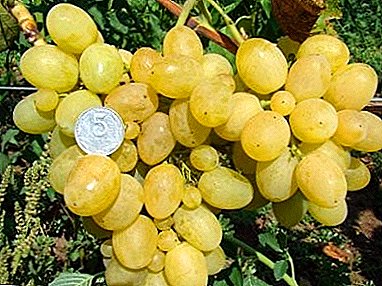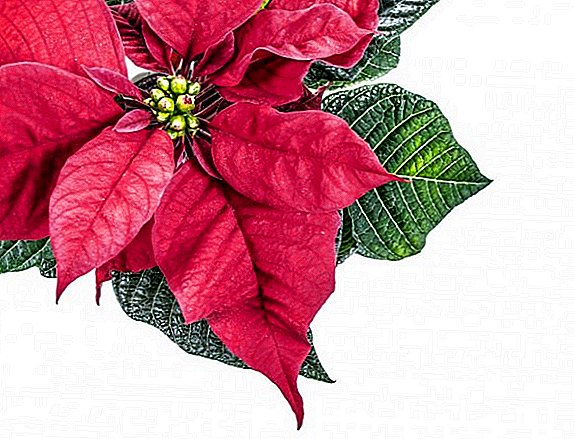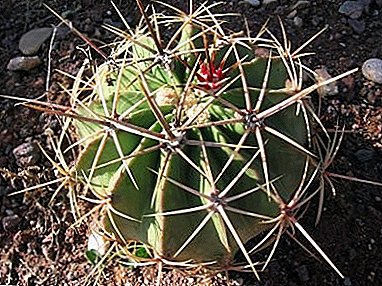
Among the various indoor plants, desert cacti never cease to lose popularity among lovers of flowers.
Many housewives consider them ideal plants for growing in city apartments.
They are unpretentious, do not require time-consuming care, attract unusual appearance and beautiful (albeit rare) flowering. Undoubtedly, Ferocactus deserve special attention.
The origin and characteristics of the genus
Motherland plants - North America. It is also distributed in Mexico, South and Southeast America, Queretaro, California, Oaxaca and other areas.
Its name comes from the Latin word. feruswhat is translated means "wild", "hard".
It is a desert, thermophilic, rounded plant, completely covered with thorns. Endowed with high ribs, straight and hooked spines.
Flowers of large size, with a short tube, different shades. The plant is well adapted to a dry, hot climate, can go without water for a long time.
Kinds
 In home culture, various types of ferocactus are grown. Discover the most popular.
In home culture, various types of ferocactus are grown. Discover the most popular.
Ferocus Wide-eyed
Synonyms: Latispinus, "Devil's language". Endowed with a spherical large stem, about 35 cm in diameter. Pink flowers.
Ribs tight 15-20 pieces. Four central spines. One of them is bent at the end in the form of a hook. 7-10 radial spines.
Ford Ferocactus
It has a gray-green, spherical stem with 20 ribs. Radial spines bright, pale, wide, about 15 pieces.
The central spines are hooked, 4-7 piecesreddish gray. The flowers are purple.
Ferocactus Powerful
Enough large representative. Forms a group of several stems up to 1 meter in height and 3 meters in diameter. Eight ribs.
The number and length of spines may vary. Flowers are bright yellow, small.
Ferocactus
The height of a cylindrical stem is about 1 meter and a diameter of 30-35 cm.
Cactus attracts attention due to the longest spines among the rest of the family - 20-27 cm long, brown-yellow color, pink at the end. The flowers are yellow.
Ferocactus Cylindrical or Asanthic
 Single cylindrical stalks, about 3 meters high and 50 cm in diameter.
Single cylindrical stalks, about 3 meters high and 50 cm in diameter.
Endowed with 30 straight ribs, divided into tubercles.
The central spikes may vary in size, shape and color, often flattened, hooked at the end, 10-15 cm long.
Flowers are orange, yellow.
Ferocactus Imeri
The stem is 1.5 meters tall, with sparse ribs. A young plant has tubercles on its ribs.
Radial spines 5-8, central one, straight, curved, 8 cm long, color can be white or red.
Flowers are red with yellow spots.
Ferocactus Porcupine
Perennial with a blue-green spherical stem with twenty-four ribs that are covered with protruding brown spikes. The flowers are bell-shaped, single, 3-3.5 cm, with a small floral tube, are formed in summer. Petals are yellow.
A photo
Below the photo shows the bright representatives of the cactus family Ferocactus:





Home care
The plant is characterized by not difficult care. For this, it is often loved to grow as an indoor flower.
Features care after purchase
Before buying, you need to immediately take care of purchasing a suitable pot and substrate. In the store, flowers are in temporary storage tanks that are not suitable for permanent cultivation.
- pot choose about one size larger previous;
- substrate is better to buy a special, designed for succulents and cacti. You can make the soil yourself, Mixing leaf and sod land in equal proportionsby adding crushed brick chips for drainage, peat, sand;
- during transplantation, do not forget to inspect the root system. She must be healthy, strong.
Lighting
 Home needs to create good lighting conditions.
Home needs to create good lighting conditions.
The best place - south facing window sills.
On cloudy autumn days it is recommended to take care of an additional source of lighting.
In the winter, you must also take care of additional lighting.
Temperature
Spring and summer - moderate and warm, 20-26 degrees. In winter, it is reduced to 12-15 degrees.
On warm summer days, you can take the flower to the open air.
The flower is sensitive to temperature extremes.
Air humidity
Additional moisture is not required. It is recommended to spray a flower with water only on hot days in order to freshen up and knock off dust.
Watering
Spring and summer need moderate watering.. Substrate should dry well between waterings.
Moisture stagnation is dangerous for the plant and may lead to rotting of the roots. In winter, watering is stopped.
Flow water can not be used. It should be at room temperature and be sure to stand for 20-24 hours.
Fertilizers
 In nature, the flower grows on soil depleted in nutrients. He can do without dressings.
In nature, the flower grows on soil depleted in nutrients. He can do without dressings.
Some flower growers use fertilizers, but they can be applied no more than once a month and only in spring and summer.
Bloom
It comes in the summer. During this period, it is recommended to increase the frequency of irrigation and not to change the location of the pot.
Transfer
Young plants are transplanted every spring, and adults only as needed (about once every 2-3 years).
Ferocactus is sensitive to transplants and can perebalivat long after them.
Breeding
For breeding use cuttings or seeds.
Easier to do it the first way. Cuttings before planting a little dried in for two days. Then placed in a pot filled with charcoal, sand or expanded clay.
Cover the top with a glass jar, which will create greenhouse conditions until rooting. Once a day, the jar is removed, ventilated and moistened (if required).
When will the rootsyou can proceed to seating.
 The seed breeding process is more laborious and time consuming.
The seed breeding process is more laborious and time consuming.
Initially, they are placed in a napkin and left in a saucer with water for 24 hours. Seeds will swell up, will quickly open and will sprout.
Before planting, the substrate is moistened and disinfected. Seeds are placed on top of the substrate and sprinkled.
Capacity covered with glass or film.
After 4 weeks, shoots will appear.
After that, the pot is opened and put on the windowsill. A little later they can sit down.
Diseases and pests
Ferocactus has good immunity. Problems arise only in case of improper care.
- Excess moisture often leads to the appearance of rot. It is important to recognize the disease in time, and transplant the flower into a new container and substrate.
The roots are thoroughly washed, decayed and disinfected in a weak potassium permanganate solution.
- In a stuffy, hot room flower can attack aphid. It is collected with a cotton alcohol swab, the affected parts are removed, treated with insecticides.
- Dangerous enemies for ferocactus are a mealybug and scalefish. Fumigation of the plant with preparations containing copper has a positive effect.
You can also process the plant alcohol swabs.
Ferocactus has long attracted the attention of flower growers. He fell in love with an unusual, exotic look, unpretentious care, beautiful flowering.
If you give the plant your care and carefor a long time it will serve as a real decoration of any modern apartment.


